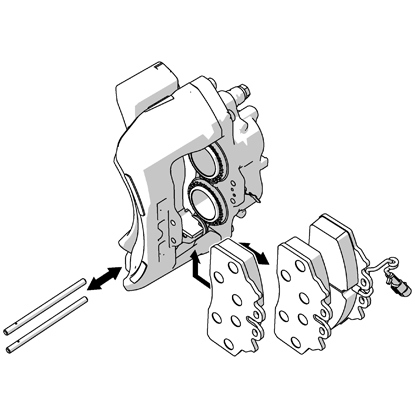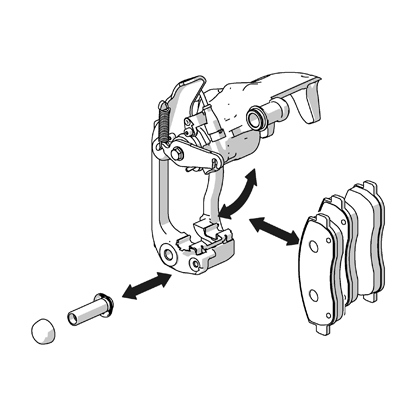Instructions for replacing the brake pads on cars and light commercial vehicles
These fitting instructions are a guideline for standard repair work and do not take into consideration any special features which might apply to the different brake systems. The special instructions issued by vehicle and brake system manufacturers must be followed in detail.
Brake pads must be replaced in axle sets. Only use brake pads that are specifically recommended for your particular vehicle type.
Before you start working on the braking system, attach a warning notice to the steering wheel to indicate that the vehicle is under repair, chock the wheels not being worked on, jack up the vehicle and ensure its stability.
We recommend you start replacing the pads on one side of the axle at a time.
The second brake may serve as a guide for the correct positioning of the individual parts during reassembly.
WARNING! Springs/clips holding down the pads may be under spring tension; relieve in a controlled fashion and keep in place using the caliper body.
Do not operate the brake once the pads have been removed.

1. Remove the cover plates, where present.
b) Pad replacement with partial disassembly of the caliper: For fist caliper. If pad removal from the top is not possible, see Fig. 3

3. Push the piston back and pivot out or remove the caliper body. Do not detach the brake tubes.
CAUTION! Do not clean components of the braking system with compressed air, a stiff brush or similar. Do not raise fine dust which, if inhaled, can be harmful to health. Wear a respirator, if working in a poorly ventilated area. Do not degrease guides and caliper spring assemblies, as they require special grease. When the caliper has difficulty sliding, slightly grease the sliding surfaces with special grease according to the instructions provided by the vehicle or caliper manufacturer. The friction materials of the brake pads and discs must not come into contact with the greases used, as this could lead to brake failure; if this should happen, degrease the discs and use new brake pads. Replace corroded guides.
5. With stepped pistons, check the correct position using dedicated piston gauges and readjust, if necessary.
9. Brakes combined with a mechanical parking brake clearance adjustment feature must have free travel after repeated brake actuations. Follow the instructions provided by the vehicle manufacturer.
WARNING! If inappropriately handled, brake fluid may cause serious injury or damage. Observe the brake fluid manufacturer’s instructions.
CAUTION! To re-position the brake pads correctly, repeatedly operate the brake once the vehicle is back on the ground.
Repeat this process until the brake pedal travel has stabilised at approx. one-third of its total travel. At a constant maximum pedal force, the pedal travel must not change even over a prolonged period of application.
CAUTION! If the pressure point and consistency cannot be achieved, recheck the entire braking system, as otherwise the risk of a brake failure cannot be ruled out.Recheck the braking system for leaks.
2. Recheck the brake fluid level and replenish up to the maximum filling line, if necessary. Use only new brake fluid of the grade specified for the particular vehicle type.
WARNING! If inappropriately handled, brake fluid may cause serious injury or damage. Observe the brake fluid manufacturer’s instructions. Perform trial brake applications at low speeds keeping in mind that brake effectiveness may be somewhat reduced during the first brake applications. Do not apply excessive force or perform continuous brake applications in order to achieve faster brake disc pad running-in
3. Always observe the running in instructions provided by the vehicle manufacturer.
This Brembo product has been designed to comply with all applicable safety standards. Products are not intended to be used differently from the specific use for which they have been designed and manufactured. Use for any other purpose, or any modification to or tampering with the Product can affect the performance of the Product and may render the Product unsafe.
Such modification or improper use will void the Limited Warranty, and may subject the individual so using the Product to liability for bodily injury or property damage to others
Brake pads are subject to wear and must therefore be checked at regular intervals.
If the thickness of friction material remaining on a pad is less than 2 mm or the wear indicator lights up, replace all the pads on an axle.
Brembo EV KIT discs and Brembo EV Kit pads must always be fitted in combination with one another. Combining them with different products could jeopardise the proper functioning of the KIT.
In these instructions, the “DANGER!” warning means procedures which, if not observed, have a high degree of probability that they will cause serious injury or even death. “CAUTION”” means procedures which, if not observed, could result in physical damage whereas “WARNING!” means procedures which, if not observed, could possibly cause damage to the vehicle.
DANGER!
Before commencing replacement, ascertain that the spare parts are suitable for the make and model of the vehicle. This Product is vital to the safe operation of the vehicle on which it is installed, and it is intended to be installed only by a skilled, qualified individual who has been trained and/or is experienced in the installation and use for which the Product is intended.
The installer must be equipped with the proper tools of his trade, and with the knowledge and experience to deal with vehicle repairs. Improper or incorrect installation, whether caused by a failure to follow these Instructions faithfully and completely or otherwise, will void the Limited Warranty and could subject the installer to liability in the event of personal injury or property damage.
Brembo shall not be liable for any damage or injury caused to or by any person operating a vehicle on which a replacement product has been improperly installed.
CAUTION!
Replaced parts must be disposed of in accordance with the law.
It is vital to avoid sharply striking and/or damaging the Product, its parts and its components, as this can impair their efficiency and may cause them to malfunction. If necessary, replace any damaged part or component. To avoid injury we recommend the following:- Always wear gloves during disassembly and assembly of components with sharp edges.
- Do not allow skin surface to make direct contact with the friction material of pads and brake shoes since this could cause abrasions.
- Do not bring the friction material of the brake pads, discs, calipers, brake tubes, etc. into contact with greases, oils, other lubricants or mineral-oil based cleaning agents as this could lead to brake failure. If necessary, replace any parts which became contaminated. Brake pads must be replaced in axle sets.
- Do not use any sharp tools, as inappropriate use of these might cause damage. Use special tools only (torque spanner, expanding tool, pull-out hooks, etc.).
- Should damage be observed on any part of the braking system while working on it, it must be remedied appropriately.
Þessi ábyrgð er eina ábyrgðin sem veitt er í tengslum við þessa vöru og kemur í stað hvers kyns annarra ábyrgða, hvort sem þær eru munnlegar eða skriflegar.






